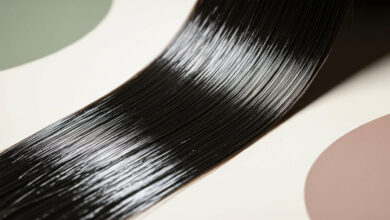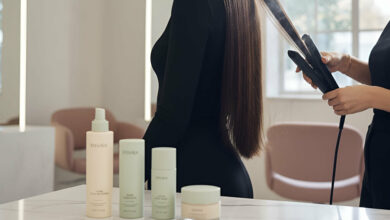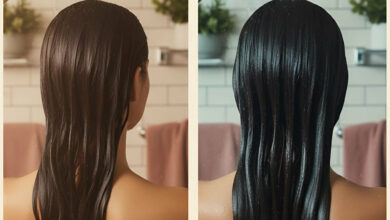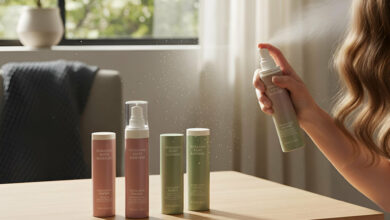Are Hyaluronic Acid Serums as Effective for Hair as They Are for Skin?
Table of contents
- The “Skinification” of Hair: Can Your Face Serum Transform Your Hair?
- The Science (Part 1): Hyaluronic Acid on Your SCALP
- The Science (Part 2): Hyaluronic Acid on Your HAIR STRANDS
- The At-a-Glance Comparison Table
- The Pro Method: How to Use HA Serum Correctly on Hair
- The Verdict: A Hydrating Styler, Not a Deep Repairer
The “Skinification” of Hair: Can Your Face Serum Transform Your Hair?
We all love what Hyaluronic Acid does for our faces. This “moisture magnet” ingredient is the hero of any hydrating skincare routine, known for its ability to plump the skin, smooth fine lines, and deliver a dewy, youthful glow. With the “skinification” of hair care now a major trend, the inevitable question arises: can this miracle hydrating serum bring those same transformative results to our dry, dull hair?
Is Hyaluronic Acid for hair the same as it is for skin? Or is it just a marketing gimmick?
The answer is a fascinating “yes and no,” and it depends entirely on where and how you apply it. We’re diving into the science to explain what Hyaluronic Acid can—and cannot—do for your scalp and your hair strands.
The Science (Part 1): Hyaluronic Acid on Your SCALP
The most important thing to understand is this: your scalp is skin. Therefore, Hyaluronic Acid behaves on your scalp almost exactly as it does on your face.
- Deep Hydration: As a powerful humectant, it draws moisture into the skin of the scalp, effectively hydrating a dry, tight, and itchy scalp.
- Barrier Support: By keeping the scalp hydrated, it helps to support the scalp’s natural skin barrier. A healthy, resilient barrier is less prone to irritation and inflammation.
- Creates a Healthy Foundation: A healthy, well-hydrated scalp is the optimal environment for promoting strong and healthy hair growth.
The Science (Part 2): Hyaluronic Acid on Your HAIR STRANDS
This is where things get different. Your hair strands are non-living keratin fibers. They cannot produce their own moisture. Here, Hyaluronic Acid acts as a topical treatment.
- How It Works: Hyaluronic Acid acts as a “humectant film” on the surface of the hair strand. It attracts and binds water molecules from the environment to the outside of your hair.
- The Visible Effects: This surface layer of moisture helps to temporarily smooth the hair’s cuticle, which reduces frizz and dramatically improves hair shine. It can make dull hair appear instantly glossier and healthier.
- The Crucial Caveat (The “Reverse Effect”): In very dry weather (low humidity), if there is no moisture in the air for the HA to grab onto, it can pull moisture from the inside of your hair strand, potentially making your hair feel even drier over time. This is why how you apply it is so important, as the performance of humectants is highly dependent on the relative humidity of the environment.
The At-a-Glance Comparison Table
| Feature | On the Scalp (Living Skin) | On the Hair Strands (Dead Keratin) |
| Primary Function | Deep Hydration & Barrier Support | Forms a Surface Hydrating Film |
| Key Benefit | Reduces Dryness & Itchiness | Increases Shine & Reduces Frizz |
| Long-Term Effect | Creates a Healthy Growth Environment | Temporary, cosmetic effect |
| Potential Downside | Virtually none | Can be drying in dry climates if not sealed in |
The Pro Method: How to Use HA Serum Correctly on Hair
To get all the benefits and avoid any drawbacks, follow this simple, crucial method.
- Apply to Damp Scalp and Hair. Always apply your Hyaluronic Acid serum to damp, not soaking wet, hair and scalp. This gives the HA molecules the water they need to bind to.
- Focus on the Scalp First. Using a dropper, apply the serum directly to your scalp in several sections. Gently massage it in with your fingertips.
- Work It Down the Strands. Take another drop or two and smooth it over the mid-lengths and ends of your hair.
- (The Most Important Step): SEAL IT IN. This is the vital step that prevents the “reverse effect.” After applying the HA serum, you must apply an occlusive product on top to lock the moisture in. Use a few drops of a hair oil or a leave-in conditioner containing silicones. This creates a seal, preventing the water that the HA has attracted from evaporating.
The Verdict: A Hydrating Styler, Not a Deep Repairer
So, are Hyaluronic Acid serums as effective for hair as they are for skin?
- For your scalp, the answer is yes. It is a true, deeply hydrating skincare treatment.
- For your hair strands, the answer is no, it’s not the same. It is not a deep, internal repairer like a protein mask. Instead, it is a brilliant hydrating styler.
Think of Hyaluronic Acid for your hair as a powerful tool for boosting instant hair shine and taming frizz, as long as you use it correctly by applying it to damp hair and sealing it in. It’s a smart and effective addition to your hair care arsenal for achieving a glossy, healthy-looking finish.
This role as a “hydrating styler” makes Hyaluronic Acid a key modern technique for achieving a “glossy, healthy-looking finish”. It is one of the essential tools in the complete journey of How to Get Shiny, Glossy Hair: A Complete Scientific Guide.






